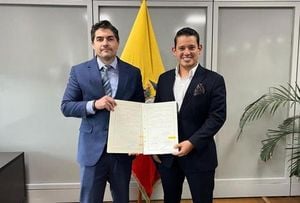In a significant diplomatic move, Ukraine and the United States have signed a resource deal that is being hailed by many in Kyiv as a triumph of Ukrainian diplomacy. This agreement, finalized on May 1, 2025, aims to establish an investment fund to aid Ukraine's recovery from the ongoing conflict with Russia, which has persisted for more than three years. While the long-term implications of this deal may only become clear over time, the immediate reactions from both sides suggest a cautious optimism.
As the signing of the deal unfolds, it becomes evident that the U.S. will benefit significantly from this partnership. President Donald Trump, speaking on NewsNation shortly after the agreement was announced, emphasized that this deal would help the U.S. recoup its substantial financial support for Ukraine, which he claimed amounted to $350 billion. He stated, "We will receive rare metals. They have great rare earth metals. I mean certain minerals, materials. They have things that are not found in many other places; this is a major asset. And today we signed a deal that will yield us much more than $350 billion." This statement highlights the potential economic advantages for the U.S. as it engages more deeply with Ukraine's resource sector.
Despite the optimism, the deal has not been without its critics. The New York Times reported that the Trump administration has not clarified whether the agreement includes military support for Ukraine. Two anonymous sources familiar with the negotiations indicated that the final deal does not guarantee future U.S. security assistance, which could undermine its significance if hostilities continue. This uncertainty casts a shadow over the agreement, as many in Kyiv hope that it will lead to a reevaluation of Ukraine's role in U.S. foreign policy.
The signing of the resource deal also introduces a new dynamic into the complex triangle of U.S.-Russia-Ukraine relations. As Ukraine and Russia vie for favor with the U.S., the agreement appears to reinforce Ukraine's position. Many commentators in Kyiv view the deal as a diplomatic victory, noting that it does not impose any obligations on Ukraine for past U.S. assistance and establishes a 50/50 partnership in managing the newly created investment fund. This fund is expected to be pivotal in Ukraine's reconstruction efforts, allowing for equal input from both nations.
Yulia Sviridenko, Ukraine's Minister of Economy, who traveled to Washington for the signing, stated on her Facebook page that the fund would not include pre-existing infrastructure and that all resources in Ukraine would remain under Ukrainian control. "All resources on our territory and in territorial waters belong to Ukraine. It is the Ukrainian state that determines where and what to extract. The subsoil remains in Ukrainian ownership," she emphasized. This assertion is crucial for Kyiv as it seeks to maintain sovereignty over its natural resources amid the ongoing conflict.
However, Kyiv is also aware of the risks associated with the deal. Concerns have been raised about potential losses in budget revenues and the lack of security guarantees in the agreement. Many analysts believe that these issues will need to be addressed as they arise, indicating a need for ongoing vigilance and negotiation on Ukraine's part.
The timing of the agreement coincides with a pivotal moment in U.S. politics, as Trump approaches the centenary of his presidency. Some observers speculate that this deal serves to bolster Trump's image as a deal-maker on the international stage, especially as he faces scrutiny over his administration's handling of foreign relations. The deal could also serve to distance Trump from Russia, as his recent rhetoric has increasingly reflected frustration with Moscow's actions in Ukraine.
Moreover, there are indications that the U.S. may be preparing to lift restrictions on military sales to Ukraine, which had been suspended by Trump upon taking office. Reports suggest that after the resource deal was finalized, the U.S. unblocked commercial sales of weapons to Ukraine, although these would need to be purchased rather than provided as grants. This shift could provide Ukraine with much-needed military resources as it continues to defend itself against Russian aggression.
Yet, as the situation develops, it remains essential to monitor how the dynamics between the U.S., Ukraine, and Russia evolve. The agreement could potentially lead to a more favorable environment for peace negotiations, particularly if it encourages Trump to view Ukraine as a strategic partner rather than merely a financial burden. The hope among many in Kyiv is that this deal will not only help stabilize Ukraine's economy but also contribute to a broader resolution to the conflict with Russia.
In conclusion, while the resource deal between Ukraine and the United States marks a significant step forward in their bilateral relations, it is accompanied by a host of uncertainties and challenges. The coming months will be critical in determining whether this agreement will yield the anticipated benefits for both nations, and whether it will facilitate a path toward lasting peace in the region.





